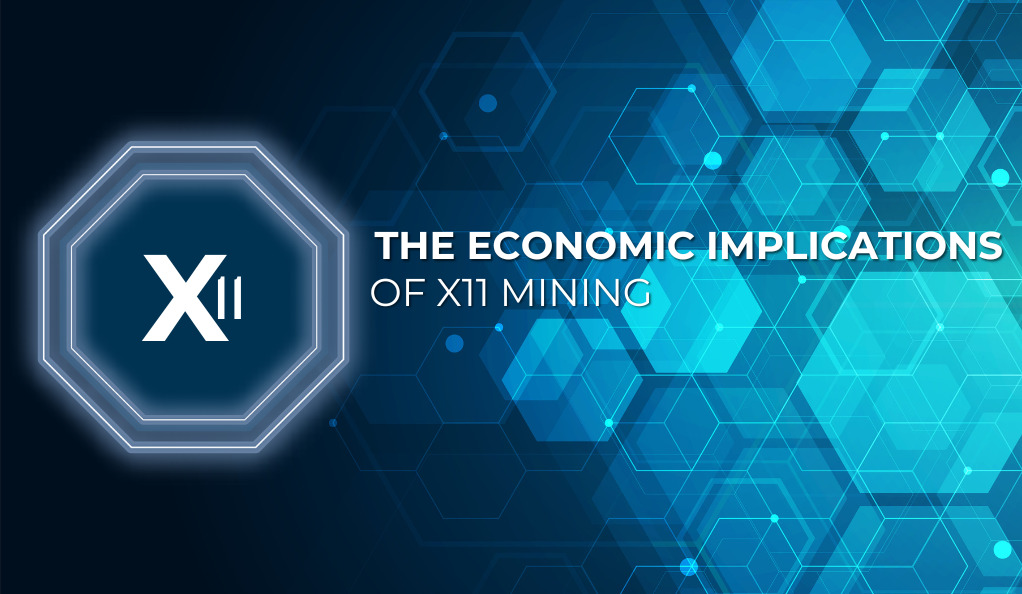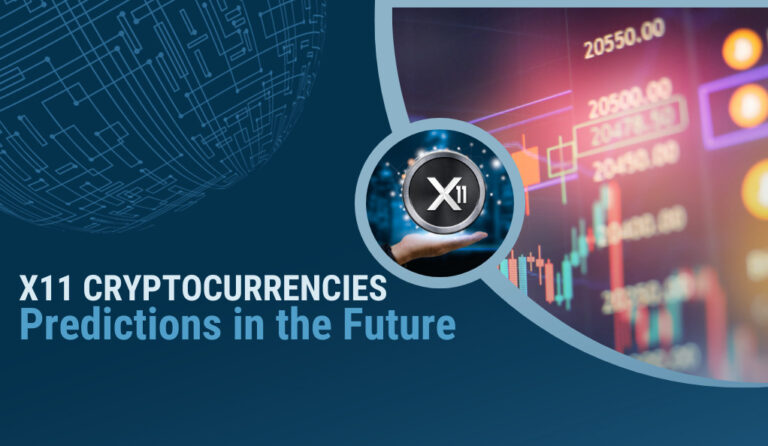The world of cryptocurrency is vast and diverse, with various algorithms driving the mining processes of different coins. One such algorithm that has garnered attention in the crypto community is the X11 algorithm. This section aims to provide a comprehensive introduction to X11 mining, its significance, and its role in the broader cryptocurrency landscape.
What is the X11 Algorithm?
The X11 algorithm is a unique hashing algorithm used for mining certain cryptocurrencies. Unlike singular algorithms like SHA-256 (used by Bitcoin), X11 is a chained hashing algorithm, comprising 11 different scientific hashing functions. This combination ensures a higher level of security and resistance to potential attacks.
| Hashing Function | Purpose |
|---|---|
| BLAKE | Speed and security |
| BMW | Cryptographic robustness |
| Groestl | Energy efficiency |
| JH | Security against differential cryptanalysis |
| Keccak | Resistance to various attack vectors |
| Skein | Speed and security |
| Luffa | Parallelism in cryptographic operations |
| Cubehash | Fast transformations and good avalanche |
| Shavite | Speed in hardware implementations |
| SIMD | Parallelism in cryptographic operations |
| Echo | Resistance against side-channel attacks |
Significance of X11 in the Cryptocurrency World
The X11 algorithm has carved a distinct niche within the cryptocurrency realm, offering a unique blend of security and efficiency that sets it apart. Unlike singular algorithms, X11’s design incorporates 11 different scientific hashing functions, providing a robust defense against potential vulnerabilities. If one function is compromised, the remaining ten offer layers of security, ensuring the integrity of the system. Additionally, X11 is renowned for its energy efficiency, often consuming less power compared to other algorithms like Bitcoin’s SHA-256. This not only translates to reduced costs for miners but also positions X11 as a more environmentally-friendly choice. Initially designed to resist the dominance of ASIC miners, X11 aimed to promote decentralization in mining. While ASICs tailored for X11 have since emerged, the algorithm’s inherent complexity ensures a balanced playing field, fostering a diverse and inclusive mining community.
The Economics of Cryptocurrency Mining
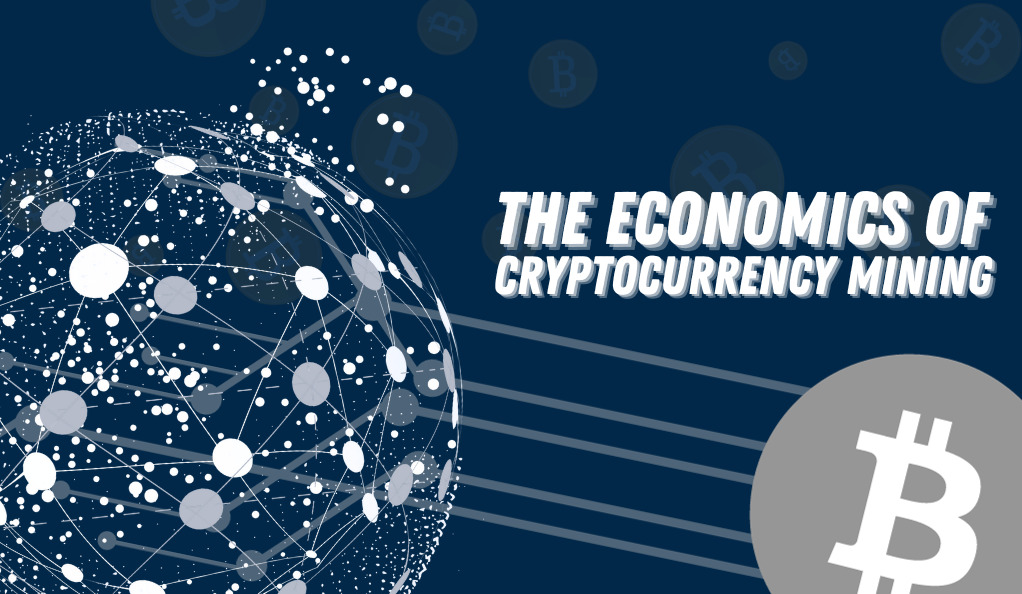
Cryptocurrency mining is not merely a technological endeavor; it’s a complex economic activity with profound implications for miners, investors, and the broader financial ecosystem. As we delve deeper into the world of X11 mining, understanding the underlying economics becomes paramount.
Understanding Costs and Revenues
At its core, the economics of cryptocurrency mining revolves around two primary factors: costs and potential revenues. The balance between these two determines the profitability of mining operations.
- Costs: These are the expenses incurred by miners to validate and add new transactions to a blockchain. They can be direct, like the cost of hardware and electricity, or indirect, such as maintenance and cooling costs.
- Revenues: This is the income miners earn from their efforts. It primarily comes from block rewards, which are new coins minted and awarded to miners for adding a new block to the blockchain. Additionally, miners can earn from transaction fees, which users pay to have their transactions included in a block.
Economic Incentives in Mining
In the decentralized cryptocurrency ecosystem, economic incentives drive mining. Miners are primarily motivated by block rewards, which compensate them with newly minted coins for adding blocks to the blockchain. Additionally, transaction fees offer added earnings, as miners prioritize transactions with higher fees. The system’s self-regulating nature, adjusting mining difficulty based on total computational power, ensures a consistent and secure blockchain, all underpinned by these economic incentives.
The Balancing Act: Costs vs. Revenues
For mining to be profitable, the potential revenues must outweigh the costs. As the price of a cryptocurrency rises, so does the incentive to mine it. However, as more miners join the network, the difficulty of mining increases, leading to higher costs in terms of computational power and energy consumption.
For instance, during a bull market where the price of a cryptocurrency skyrockets, there might be a surge in the number of miners, leading to increased competition and higher difficulty. Conversely, if the price drops significantly, it might no longer be profitable for some miners to continue, especially if their operational costs remain high.
Costs Associated with X11 Mining
Mining, while lucrative under the right conditions, is also associated with various costs. For those utilizing the X11 algorithm, understanding these costs is crucial to ensure profitability. Let’s break down the primary expenses linked to X11 mining.
Hardware Costs
The backbone of any mining operation is the hardware. For X11 mining:
- ASIC Miners: Application-Specific Integrated Circuits (ASICs) are specialized devices designed for mining specific algorithms. Over the years, ASICs tailored for X11 have been developed, offering high performance but at a significant cost.
- GPUs: Before the dominance of ASICs, Graphics Processing Units (GPUs) were the go-to hardware for X11 mining. While they offer flexibility in mining various coins, their efficiency is generally lower than ASICs for X11.
The choice between ASICs and GPUs largely depends on the miner’s budget, long-term goals, and electricity costs.
Energy Expenses
Cryptocurrency mining is inherently energy-intensive, with the computational demands of validating transactions and securing networks consuming vast amounts of electricity. These energy expenses play a crucial role in determining the profitability and sustainability of mining operations. The cost of electricity can vary significantly based on geographic location, making regions with lower electricity rates more attractive for mining. Furthermore, the efficiency of the mining hardware itself is pivotal. Modern equipment, especially newer ASICs and GPUs, are designed to offer higher performance with reduced power consumption, striking a balance between operational costs and mining output.
Cooling Costs
Mining hardware, especially when running 24/7, generates a lot of heat. Efficient cooling is essential to maintain the longevity of the equipment.
- Cooling Systems: Whether it’s air conditioning, fans, or specialized cooling solutions, there’s a cost associated with keeping the mining setup at optimal temperatures.
- Environmental Factors: Miners in cooler regions might spend less on cooling compared to those in hotter climates.
Maintenance and Repair Costs
Maintenance and repair are integral components of the cryptocurrency mining lifecycle, ensuring the longevity and efficiency of the hardware. As mining equipment operates continuously, it’s subjected to wear and tear, necessitating regular upkeep. This maintenance can encompass tasks like cleaning, software updates, and part replacements. Over time, certain components might malfunction or degrade, leading to the need for repairs or even complete hardware replacements. While these costs might seem ancillary, they play a pivotal role in the overall profitability of mining operations, as well-maintained equipment can lead to optimized performance and reduced downtime.
Transaction Fees
While not a cost, transaction fees are a crucial aspect of mining economics.
- Earning Potential: Miners may earn transaction fees in addition to block rewards. As the network sees more activity, the potential for earning higher transaction fees increases.
- Network Congestion: During times of high network activity, users might pay higher transaction fees to prioritize their transactions, leading to increased earnings for miners.
Revenues from X11 Mining
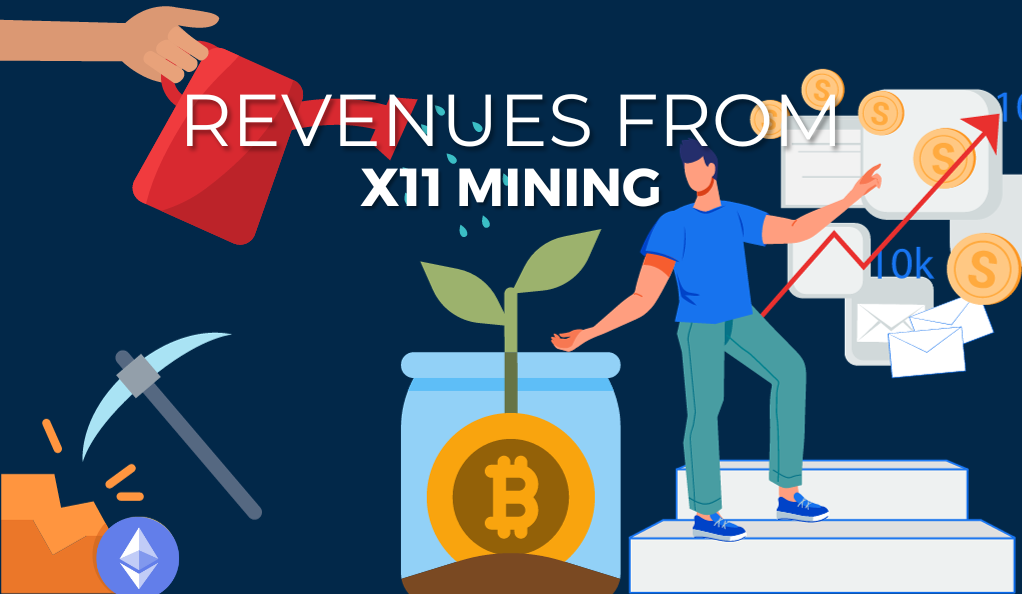
While the costs of mining are undeniably significant, the potential revenues can be equally, if not more, substantial. In the realm of X11 mining, understanding the sources of revenue and the factors influencing them is crucial for maximizing profitability.
Block Rewards: The Primary Revenue Stream
At the heart of mining revenues is the block reward.
- Minting New Coins: For every block added to the blockchain, miners are rewarded with a set number of newly minted coins. This reward serves as the primary incentive for miners to secure the network and validate transactions.
- Dynamic Adjustments: The value of block rewards can change over time. Many cryptocurrencies implement halving events, where the block reward is reduced by half after a certain number of blocks. This mechanism ensures a controlled supply of the cryptocurrency.
Transaction Fees: An Additional Boost
Beyond the foundational block rewards, transaction fees offer miners an additional and often lucrative revenue stream. As users initiate transactions on the network, they can opt to pay fees to ensure their transactions are processed promptly. Miners, in turn, prioritize these fee-bearing transactions, leading to faster confirmations and added income. The potential earnings from transaction fees are closely tied to the network’s overall activity. During periods of high congestion or increased transaction volumes, users are more inclined to pay higher fees, resulting in a boost in miners’ earnings. This dynamic interplay between user demand and miner incentives further underscores the economic intricacies of the cryptocurrency ecosystem.
Factors Influencing Revenue
Several variables can impact a miner’s revenue potential:
- Cryptocurrency Prices: The most obvious factor is the market price of the cryptocurrency being mined. A surge in price can lead to significantly higher revenues, while a drop can reduce profitability.
- Mining Difficulty: As more miners join the network, the difficulty of mining increases. Higher difficulty means more competition for block rewards, potentially reducing individual miners’ earnings.
- Hardware Efficiency: The efficiency of the mining hardware directly impacts the amount of cryptocurrency mined. More efficient hardware can lead to higher revenues.
- Network Upgrades: Cryptocurrencies often undergo network upgrades or forks. These can introduce changes to block rewards, transaction fees, or mining algorithms, influencing revenue potential.
Calculating Potential Earnings
To gauge potential earnings, miners often use profitability calculators tailored for their chosen cryptocurrency. These tools factor in current prices, block rewards, hardware efficiency, electricity costs, and other variables to provide an estimate of potential earnings.
Market Trends in Cryptocurrency Mining
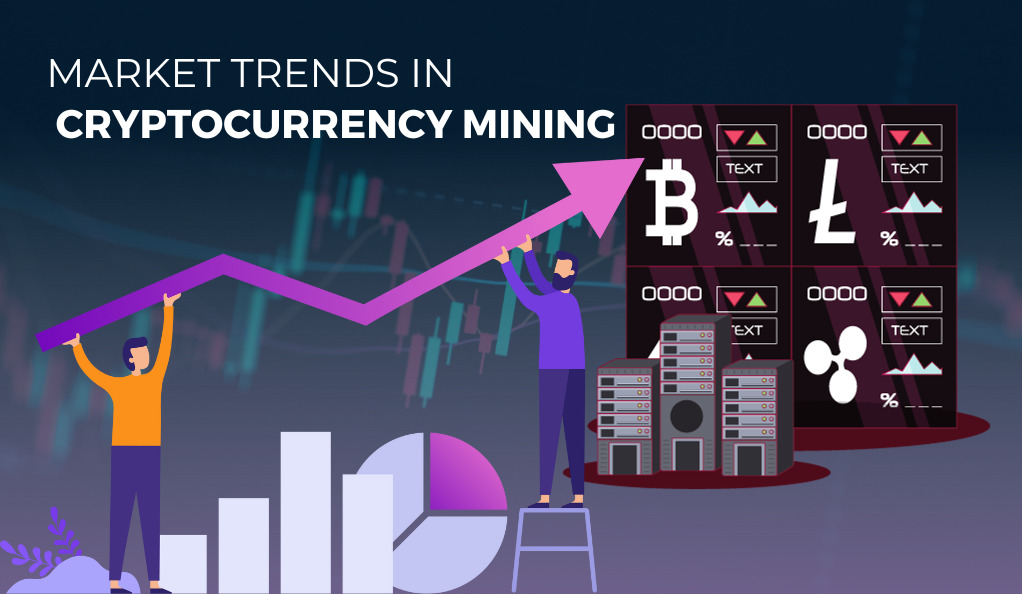
The cryptocurrency mining landscape is in a constant state of flux, shaped by technological advancements, market dynamics, and external factors like regulations and global events. For those involved in X11 mining, understanding these trends is pivotal to staying ahead of the curve and ensuring sustained profitability.
Increased Competition: The Double-Edged Sword
As cryptocurrency gains mainstream acceptance, more individuals and enterprises are venturing into mining.
- Crowded Space: The influx of miners has made the space more competitive. While this validates the potential of cryptocurrency mining, it also means thinner profit margins for individual miners.
- Consolidation: With rising competition, there’s a trend towards consolidation. Larger mining pools and farms are emerging, leveraging economies of scale to optimize costs and increase their chances of earning block rewards.
The Shift Towards Specialized Hardware
The cryptocurrency mining landscape has witnessed a significant shift towards specialized hardware, driven by the relentless pursuit of efficiency and performance. In the early days, general-purpose hardware like Graphics Processing Units (GPUs) dominated the scene. However, as the competition intensified, the need for more efficient mining solutions led to the emergence of Application-Specific Integrated Circuits (ASICs). These devices, tailored specifically for mining particular algorithms, offer unparalleled performance, outstripping traditional GPUs in both speed and energy efficiency. This evolution towards specialized hardware underscores the industry’s commitment to optimizing operations, ensuring that mining remains profitable even as challenges like increased difficulty and energy costs arise.
Environmental Concerns: The Green Mining Movement
The environmental impact of cryptocurrency mining, especially Bitcoin, has been under the spotlight.
- Sustainable Mining: There’s a growing emphasis on green mining practices. Miners are exploring renewable energy sources, and some cryptocurrencies are even looking at less energy-intensive consensus mechanisms like Proof-of-Stake.
- Location Matters: Miners are relocating to regions with cheap and green electricity. Countries with abundant hydroelectric or geothermal power are becoming hotspots for mining operations.
Regulatory Developments: Navigating the Legal Landscape
As the prominence of cryptocurrency continues to grow, it increasingly intersects with the realm of regulatory oversight. Regulatory developments around the world are shaping the trajectory of the crypto industry, including the mining sector. Some countries have embraced the potential of cryptocurrency mining, offering incentives or crafting friendly regulations to foster growth. In contrast, others have approached it with caution, imposing restrictions or even outright bans, often citing concerns ranging from energy consumption to potential financial system disruptions. For miners and other stakeholders, navigating this evolving legal landscape is crucial. Staying informed and adaptable ensures that operations remain compliant, mitigating risks and capitalizing on opportunities in a world where the legal stance on cryptocurrency is still in flux.
The Rise of Altcoin Mining
While Bitcoin remains the most popular cryptocurrency, the rise of altcoins (alternative cryptocurrencies) offers new opportunities for miners.
- Diversification: Miners are diversifying their operations, mining multiple cryptocurrencies to hedge against market volatility.
- New Algorithms: Altcoins often introduce new mining algorithms, like X11 for Dash, providing miners with fresh avenues for revenue.
The Environmental Impact of X11 Mining
In recent years, the environmental implications of cryptocurrency mining have become a focal point of discussions, both within and outside the crypto community. As the world grapples with climate change and seeks sustainable solutions, understanding the ecological footprint of X11 mining is of paramount importance.
Energy Consumption: The Heart of the Matter
Cryptocurrency mining, by its very nature, is energy-intensive. The computational power required to maintain the network and validate transactions consumes vast amounts of electricity.
- Comparative Analysis: While X11 mining is energy-intensive, it’s essential to compare its energy consumption with other algorithms. For instance, Bitcoin’s SHA-256 is notoriously power-hungry, whereas X11, with its chained hashing approach, is often touted as more energy-efficient.
- Regional Differences: The environmental impact also varies based on where the mining takes place. Mining in regions powered predominantly by coal will have a higher carbon footprint than areas where renewable energy sources are prevalent.
Cooling and Infrastructure: The Overlooked Aspects
Cooling and infrastructure are vital yet often understated components of cryptocurrency mining. Mining hardware emits significant heat, necessitating efficient cooling solutions to ensure equipment longevity. Additionally, large-scale mining demands specialized infrastructure, from tailored facilities to optimized electrical setups. These elements, though sometimes overlooked, are crucial to the overall efficiency and sustainability of mining operations.
The Push for Green Mining
As global awareness of environmental sustainability grows, the cryptocurrency mining industry faces increasing pressure to adopt eco-friendly practices. This “Green Mining” movement emphasizes the transition to renewable energy sources, such as solar, wind, and hydroelectric power, reducing the carbon footprint of mining operations. Innovative solutions are also emerging, like heat recycling, where the heat generated from mining is repurposed for other uses. The shift towards sustainable mining not only addresses environmental concerns but also positions the industry for long-term viability in a world increasingly focused on ecological responsibility.
Proof-of-Stake (PoS) vs. Proof-of-Work (PoW)
The environmental concerns have also sparked discussions about the underlying consensus mechanisms in cryptocurrencies.
- PoS Advantages: Proof-of-Stake, a consensus mechanism where validators are chosen based on the number of coins they hold and are willing to “stake” or lock up, is inherently less energy-intensive than Proof-of-Work, where computational power determines who gets to add the next block.
- Transitioning Cryptocurrencies: Some major cryptocurrencies are considering or have already begun transitioning from PoW to PoS to address environmental concerns and scalability issues.
The Future of X11 Mining
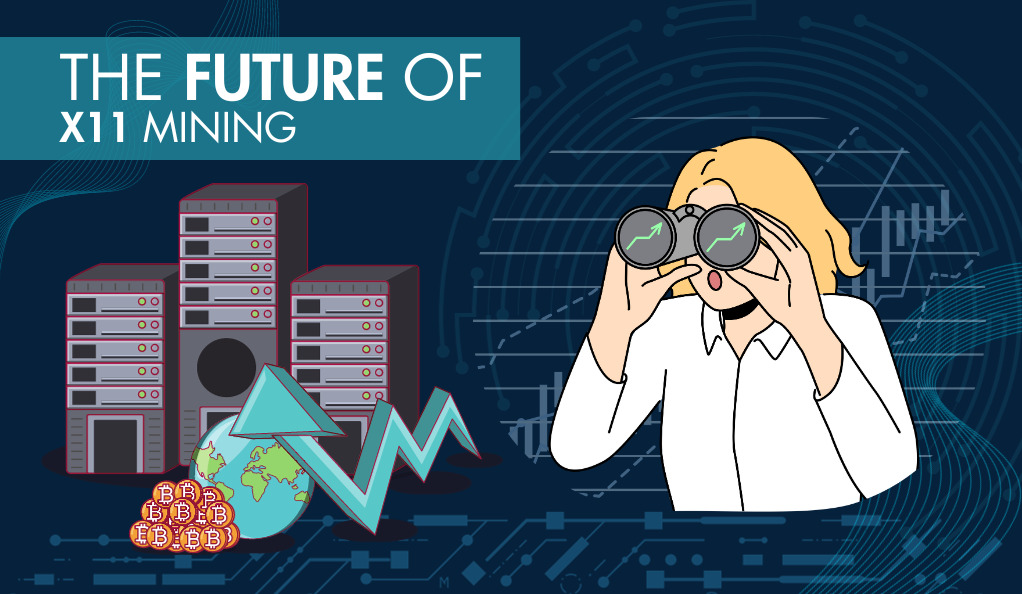
As we navigate the ever-evolving landscape of cryptocurrency, it’s essential to cast an eye towards the horizon and ponder the future of X11 mining. With technological advancements, market dynamics, and external pressures shaping its trajectory, what can miners expect in the coming years?
Technological Advancements: The Race for Efficiency
The world of crypto mining is characterized by rapid technological evolution, and X11 mining is no exception.
- Next-Gen ASICs: As the demand for efficient mining grows, we can expect the emergence of more advanced ASICs tailored for X11. These devices will offer better hash rates, consume less power, and have a longer operational lifespan.
- Improved Cooling Solutions: As hardware becomes more powerful, the need for efficient cooling solutions will grow. We might see innovations in liquid cooling, ambient cooling, and even geothermal cooling solutions tailored for mining farms.
Market Dynamics: The Role of Altcoins
While Bitcoin is the flagship of cryptocurrencies, the significance of altcoins is rapidly growing. These alternative digital currencies introduce unique features and algorithms, with X11 being a notable example. As the crypto landscape evolves, altcoins are gaining traction, offering miners diverse opportunities and avenues for revenue. Their rise not only diversifies the market but also provides a hedge against the inherent volatility, underscoring the dynamic interplay between Bitcoin and its alternatives in shaping the future of cryptocurrency mining.
External Pressures: Regulation and Environment
External factors will play a significant role in shaping the future of X11 mining.
- Regulatory Landscape: As governments worldwide grapple with the rise of cryptocurrency, regulatory stances will impact mining operations. Some regions might offer incentives, while others could impose restrictions or bans.
- Environmental Accountability: With the global focus on sustainability, miners will face increasing pressure to adopt green practices. This shift might lead to the growth of mining operations in regions with abundant renewable energy sources.
Decentralization vs. Centralization
Decentralization, a foundational principle of cryptocurrencies, champions a system where power and control are distributed rather than concentrated. However, the increasing emergence of large mining pools poses a challenge to this ideal. These pools, by aggregating the computational resources of multiple miners, can exert significant influence over the network, potentially leading to centralization. Such centralization can make the network more susceptible to attacks or manipulative practices. On the flip side, the allure of solo mining remains, especially for purists and enthusiasts who value the principle of decentralization. They view solo mining as a way to contribute to the network’s security without aligning with large pools. As the crypto landscape evolves, this tug-of-war between decentralization and centralization will continue to shape discussions, practices, and innovations in the mining community.
Conclusion
Cryptocurrency mining, with its intricate blend of technology and economics, stands at the crossroads of innovation and sustainability. The X11 algorithm, with its unique chained hashing approach, offers both challenges and opportunities in this dynamic landscape. As the crypto world continues to evolve, X11 mining presents a promising avenue, characterized by potential profitability, rapid technological advancements, and the ever-present need for environmental responsibility.
However, the future is not without its uncertainties. From market volatility and regulatory shifts to the pressing demands of environmental sustainability, miners must navigate a myriad of challenges. Yet, with adaptability, informed decision-making, and a commitment to green practices, the world of X11 mining holds immense potential for those willing to venture into its depths and embrace its complexities.
At axerunners.com, our goal is to furnish well-rounded and trustworthy information regarding cryptocurrency, finance, trading, and stocks. Nonetheless, we avoid providing financial advice and instead encourage users to conduct their own research and meticulous verification.
Read More
